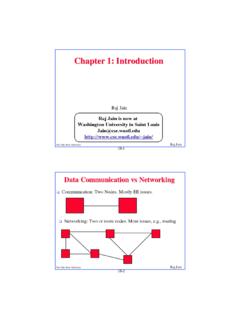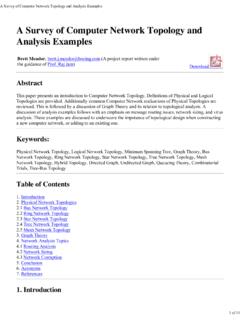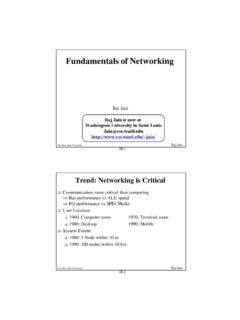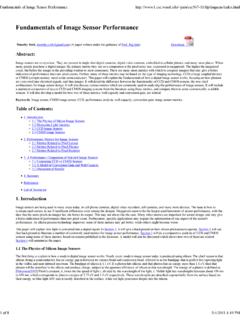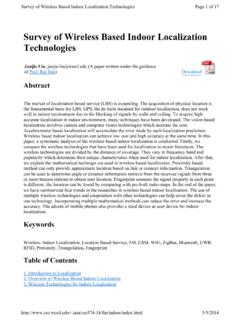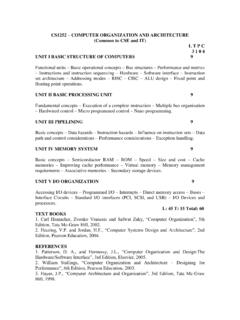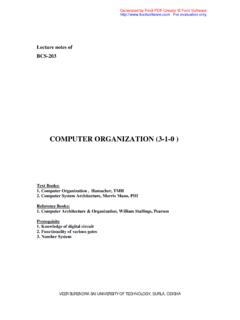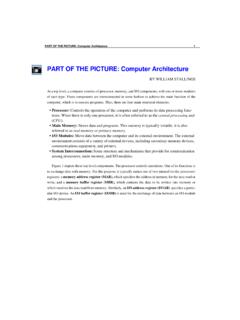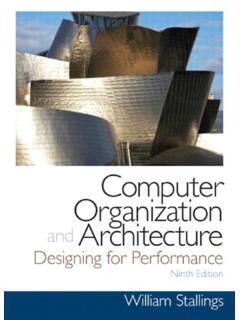Transcription of Wireless Network Security - Computer Science & …
1 Wireless Network Security Raj Jain Washington University in Saint Louis Saint Louis, MO 63130. Audio/Video recordings of this lecture are available at: ~jain/cse571-14/. Washington University in St. Louis CSE571S 2014 Raj Jain 18-1. Overview 1. Why Wireless is Insecure and What can we do about it? 2. IEEE Wireless LAN Overview 3. Legacy Security : WEP. 4. IEEE Wireless LAN Security : WPA, WPA2. These slides are based partly on Lawrie Brown's slides supplied with william stallings 's book Cryptography and Network Security : Principles and Practice, 6th Ed, 2013. Washington University in St. Louis CSE571S 2014 Raj Jain 18-2. Why Wireless is Insecure? Channel: Broadcast Eavesdropping, Jamming, Active attacks on protocols Mobility: Portable devices Not physically secured Resources: Limited memory and processing resources Need simpler Security Accessibility: May be left unattended Washington University in St.
2 Louis CSE571S 2014 Raj Jain 18-3. Wireless Network Threats 1. Accidental Association: Overlapping networks unintentionally connect to neighbors 2. Malicious Association: Malicious access points (Free public WiFi) can steal passwords 3. Ad-Hoc Networks: Two computers can exchange data 4. Nontraditional Networks: Bluetooth can be used to eavesdrop 5. MAC Spoofing: Change MAC address to match a privileged Computer 6. Man-In-The-Middle Attacks: Using rogue access point between the user and the real access point 7. Denial of Service (DoS): Keep the media busy 8. Network Injection: Spoof routing/management messages Washington University in St. Louis CSE571S 2014 Raj Jain 18-4. Countermeasures Turn-off SSID broadcast Use Cryptic SSID names Reduce signal strength Locate APs away from boundary Use encryption Use IEEE Network access control Change the router's user ID from default Change the router's password from default MAC Filtering: Only specific MAC address connect Washington University in St.
3 Louis CSE571S 2014 Raj Jain 18-5. Mobile Device Security Mobile Dynamic/no boundary Cloud 1. Lack of Physical Security : Mobiles cannot be locked 2. Not all devices can be trusted 3. Untrusted networks between device and the organization 4. Wide variety of contents on mobiles than on other computers (music, video, games, ). 5. Apps from untrusted vendors 6. Data may get on unsecured device 7. Location information may be used for attack Washington University in St. Louis CSE571S 2014 Raj Jain 18-6. Wi-Fi Operation Station Access Point Access Points (APs) periodically broadcast a beacon with SSID. (service set ID) and Security level Subscriber stations listen to these beacons, measure signal strength and determine which AP to join Subscribers can also send a Probe to find AP's in the neighborhood AP authenticates the subscriber station using shared keys Subscriber stations and AP exchange encrypted packets Subscriber station send a Disassociate message and log off Ref: Washington University in St.
4 Louis CSE571S 2014 Raj Jain 18-7. IEEE Architecture Server Distribution System IBSS. Access Access Ad-hoc Point Point Station Station Ad-hoc Station Station Station Station Basic Service Set 2nd BSS Ad-hoc Network Washington University in St. Louis CSE571S 2014 Raj Jain 18-8. IEEE Architecture (Cont). Basic Service Area (BSA) = Cell Each BSA may have several access points (APs). Basic Service Set (BSS). = Set of stations associated with one AP. Distribution System (DS) - wired backbone Extended Service Area (ESA) = Multiple BSAs interconnected via a distribution system Extended Service Set (ESS). = Set of stations in an ESA. Independent Basic Service Set (IBSS): Set of computers in ad- hoc mode. May not be connected to wired backbone. Ad-hoc networks coexist and interoperate with infrastructure- based networks Washington University in St. Louis CSE571S 2014 Raj Jain 18-9.
5 IEEE Services Association: A STA connecting with an AP. Disassociation: Termination of association. Re-association: Transfer of association from one AP to another. Mobility within BSS, within ESS, between two ESSs. MSDU Delivery: Interchange of packets between STAs Distribution: Delivery of packets between STAs possibly via the backbone distribution system Integration: Interchange of packets between STAs and wired stations connected to LANs on the distribution system Authentication: The station is authenticated De-authentication Privacy: Encryption Washington University in St. Louis CSE571S 2014 Raj Jain 18-10. Wired Equivalent Privacy (WEP). WEP Privacy similar to a wired Network Intellectual property not exposed to casual browser Not protect from hacker First encryption standard for Wireless . Defined in Provides authentication and encryption Shared Key Authentication Single key is shared by all users and access points Washington University in St.
6 Louis CSE571S 2014 Raj Jain 18-11. WEP Details Each device has 4 static WEP keys 2-bit key ID sent w Initialization Vector (IV) in clear in each packet Per-Packet encryption key =24-bit IV + one of pre-shared key Encryption Algorithm: RC4. Standard: 24 + 40 = 64-bit RC4 Key Enhanced: 24 + 104 = 128 bit RC4 key WEP allows IV to be reused CRC-32 = Integrity Check Value (ICV). Data and ICV are encrypted under per-packet encryption key Header Data CRC. Header IV Data ICV. Washington University in St. Louis CSE571S 2014 Raj Jain 18-12. WEP Encapsulation CRC-32. Data ICV. WEP Keys K1 K2 K3 K4. Xor RC4 Keystream IV WEP Key MAC hdr IV Pad KID Cipher text CRC. Washington University in St. Louis CSE571S 2014 Raj Jain 18-13. WEP Decapsulation MAC hdr IV Pad KID Cipher text CRC. WEP Keys K1 K2 K3 K4. Xor IV WEP Key Data ICV. Keystream No RC4 CRC-32 = Fail Yes Success Washington University in St.
7 Louis CSE571S 2014 Raj Jain 18-14. Ron's Cipher 4 (RC4). Developed by Ron Rivest in 1987. Trade secret. Leaked 1994. Stream Cipher A pseudo-random stream is generated using a given key and xor'ed with the input Pseudo-random stream is called One-Time pad Key can be 1 to 256 octet See the C code in the textbook [KPS]. Encryption Key Pseudo-random # generator K. Random byte Plain text data b Cipher text data . byte p byte c Washington University in St. Louis CSE571S 2014 Raj Jain 18-15. WEP Authentication Authentication is a via Challenge response using RC4 with the shared secret key. Station Access Point Challenge Response (Nonce RC4 (Nonce). encrypted under shared key) Decrypted nonce OK? Washington University in St. Louis CSE571S 2014 Raj Jain 18-16. WEP Review Four 40-bit or 104-bit Keys are manually programmed in each subscriber station and AP. A 24-bit IV and WEP key is used to form a 64b or 128b RC4.
8 Key A keystream is generated using the RC4 key A 32-bit CRC is added as Integrity check value (ICV) to the packet Plain text and keystream is xor'ed. A 32-bit CRC is added in clear. Washington University in St. Louis CSE571S 2014 Raj Jain 18-17. Problems with WEP Authentication Record one challenge/response Both plain text and encrypted text are available to attacker XOR the two to get the keystream Use that keystream and IV to encrypt any subsequent challenges Station Access Point Challenge Response (Nonce RC4 (Nonce). encrypted under shared key) Decrypted nonce OK? Washington University in St. Louis CSE571S 2014 Raj Jain 18-18. Problem with Stream Cipher Consider two packets with the same IV Same keystream b c1 = p1 b; c2 = p2 b c1 c2=p1 p2. Two packets w same IV XOR = Difference in plain text 50% chance of using the same IV in 4823 packets. Recovered ICV matches Plain text is correct Possible to recover all 224 keystreams in a few hours Washington University in St.
9 Louis CSE571S 2014 Raj Jain 18-19. Problems with WEP ICV. CRC is used as ICV. CRC: Message polynomial is shifted and divided by CRC. polynomial, the remainder is sent as CRC. p = pnxn + pn 1xn 1 + + p0x0. Remainder(p+q, c). = Remainder(p, c) + Remainder(q, c). ICV is linear: ICV(p+q) = ICV(p) + ICV(q). Conclusion: XOR any CRC-32 valid plain text to encrypted packet. The modified packet will pass the ICV after decryption. Washington University in St. Louis CSE571S 2014 Raj Jain 18-20. WEP Problems No centralized key management Manual key distribution Difficult to change keys Single set of Keys shared by all Frequent changes necessary No mutual authentication No user management (no use of RADIUS). IV value is too short. Not protected from reuse. Weak integrity check. Directly uses master key No protection against replay Ref: , , Washington University in St. Louis CSE571S 2014 Raj Jain 18-21.
10 Wireless LAN Security Wi-Fi Alliance Wi-Fi Protected Access (WPA). Software modification to existing WEP systems Key mixing function to generate per packet key Sequence Number to protect against replay attacks 64-bit message integrity check (MIC). Uses the same RC4 encryption Robust Security Network (RSN) or WPA2. Requires hardware replacement Counter Mode with Cipher Block Chaining Message Authentication Code Protocol (CCMP). AES encryption with counter mode Ref: , , Washington University in St. Louis CSE571S 2014 Raj Jain 18-22. Phases of Operation Washington University in St. Louis CSE571S 2014 Raj Jain 18-23. IEEE Discovery Phase STA AP. Probe Request: May I join please? Probe Response: Yes, you can. Null Authentication Request Null Authentication Response Secure Association Request Association Response with Security Parameters Encryption, Integrity, Authentication Methods Capability negotiation Confidentiality and Integrity: WEP, TKIP, CCMP, vendor specific Authentication: , Pre-shared key, vendor specific Washington University in St.

